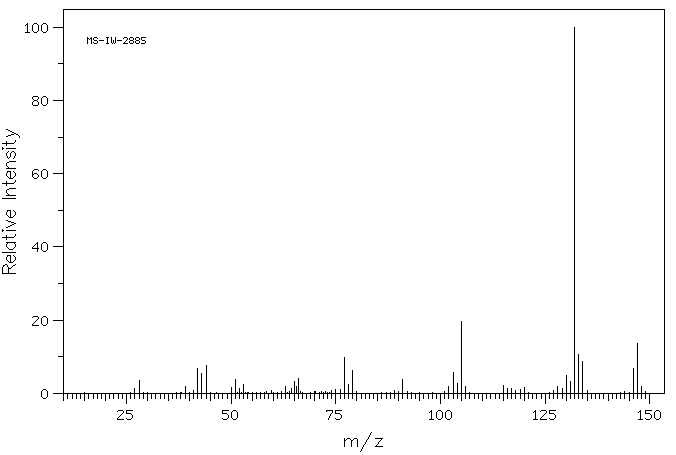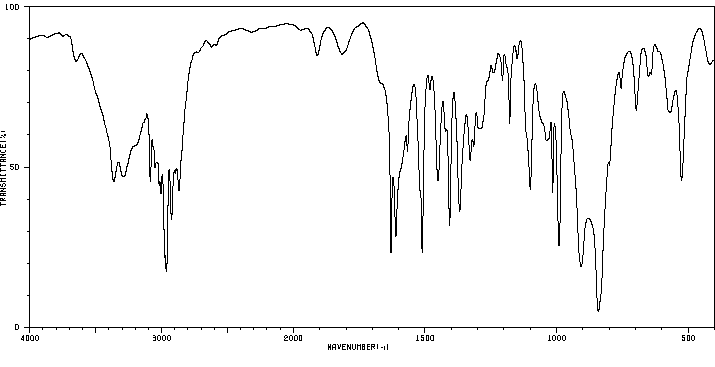R,S-1-(4-vinylphenyl)ethylamine
中文名称
——
中文别名
——
英文名称
R,S-1-(4-vinylphenyl)ethylamine
英文别名
1-(4-Vinylphenyl)ethanamine;1-(4-ethenylphenyl)ethanamine
CAS
——
化学式
C10H13N
mdl
——
分子量
147.22
InChiKey
LNQOHNKBFDWGEQ-UHFFFAOYSA-N
BEILSTEIN
——
EINECS
——
-
物化性质
-
计算性质
-
ADMET
-
安全信息
-
SDS
-
制备方法与用途
-
上下游信息
-
文献信息
-
表征谱图
-
同类化合物
-
相关功能分类
-
相关结构分类
计算性质
-
辛醇/水分配系数(LogP):2
-
重原子数:11
-
可旋转键数:2
-
环数:1.0
-
sp3杂化的碳原子比例:0.2
-
拓扑面积:26
-
氢给体数:1
-
氢受体数:1
反应信息
-
作为反应物:描述:R,S-1-(4-vinylphenyl)ethylamine 生成 S-1-(4-vinylphenyl)ethylamine 、 R-1-(4-vinylphenyl)ethylamine参考文献:名称:Polymeric Pd catalysts for the reduction of acetamidocinnamic acid azlactone and its solvolysis products摘要:Pd complexes have been obtained from linear and cross-linked copolymers of R,S-,R-, and S-1-(4-vinylphenyl)ethyl-amine (1) with styrene and divinylbenzene. Reduction of these compounds gave catalysts which were active in the reductive solvolysis of alpha-acetaminocinnamic acid azlactone (2) and hydrogenation of the solvolysis products alpha-acetamidocinnamic acid (ACA), its esters, and its 1-phenylethylamide. The catalysts showed no enantioselective properties in the reductive hydrolysis, but were more active than the catalyst obtained in the absence of the polymer (the ''monomeric'' analog). The use of polymeric catalysts has shown that, in reductive aminolysis, the chiral nucleophile plays the dominant part in determining the stereoselectivity of the reaction, rather than the chiral ligand of the catalytic complex. The polymer matrix stabilizes the low-valent state of the palladium in the complex. In the hydrogenation of ACA and its esters, the catalyst on the cross-linked polymer is much more active than its ''monomeric'' analog, but showed no enantioselectivity. Hydrogenation of acetamidocinnamic acid R- and S-1-phenylethylamides on a chiral Pd-polymer catalyst occurred with double asymmetric induction.DOI:10.1007/bf00863823
文献信息
-
ORGANIC FINE PARTICLE申请人:Daikin Industries, Ltd.公开号:US20220227907A1公开(公告)日:2022-07-21An organic fine particle capable of adhering to a substrate under a state having a particle shape, wherein the organic fine particle, when adhered to a substrate, exhibits water-repellency on the substrate, and the organic fine particle is formed of a fluorine-free polymer. Also disclosed is an organic fine particle containing: (1) a hydrophobic monomer which has one ethylenically unsaturated double bond and at least one hydrocarbon group having 3-40 carbon atoms; or (2) a polymer which has a repeating unit formed from a (meth)acrylic monomer having a polydimethylsiloxane group. Also disclosed is a method for producing the organic fine particle and a water-repellent composition which is an aqueous dispersion of the organic fine particle. Also disclosed is a textile product and method for treating the same which includes applying a treatment liquid containing the water-repellent composition to the textile product.
-
US4111863A申请人:——公开号:US4111863A公开(公告)日:1978-09-05
-
US4127730A申请人:——公开号:US4127730A公开(公告)日:1978-11-28
-
[EN] POROUS ARTICLES WITH SURFACE FUNCTIONALITY AND USES THEREOF<br/>[FR] ARTICLES POREUX A FONCTIONNALITE DE SURFACE ET LEURS UTILISATIONS申请人:FLOWGENIX CORPORATION公开号:WO1998032790A1公开(公告)日:1998-07-30(EN) Porous organic articles having no surface functionality may be treated by remote plasma discharge to introduce oxygen or nitrogen atoms directly bonded to the surface of the article, including the interstitial surface. These oxygen and nitrogen atoms provide chemical handles through which a variety of useful moieties can be bonded to the article. Modified porous organic articles are useful in the solid phase synthesis of biomolecules when nucleosides, amino acids, or their derivatives are bonded directly or indirectly to the nitrogen or oxygen atoms. Alternatively, porous solid supports can be treated to introduce chromatographically active groups, such as an anion exchanger, a cation exchanger, an hydrophobic group, a hydrazide group, a reactive group of covalent bond formation through protein amino groups, a substituent group for reversed phase chromatography, and a substituent group for chiral chromatography. Moreover, surface-functionalized porous articles comprising an immobilized diagnostic agent can be used for diagnosing or monitoring patient conditions and diseases.(FR) La présente invention concerne des articles organiques poreux ne présentant pas de fonctionnalité de surface, que l'on peut traiter par décharge de plasma à distance afin d'y introduire des atomes d'oxygène et d'azote qui se lient directement à la surface de l'article, y compris la surface intersticielle. Ces atomes d'oxygène et d'azote constituent des poignées chimiques au moyen desquelles toute une gamme de fragments utiles peuvent se lier à l'article. Les articles organiques poreux modifiés sont utiles dans la synthèse en phase solide de biomolécules lorsque des nucléosides, des acides aminés, ou leurs dérivés, sont liés directement ou indirectement aux atomes d'azote ou d'oxygène. Dans un autre mode de réalisation, on peut traiter des supports solides poreux pour y introduire des groupes chromatographiquement actifs, tels qu'un échangeur d'anions, un échangeur de cations, un groupe hydrophobe, un groupe hydrazyde, un groupe réactionnel permettant la formation d'une liaison covalente via les groupes protéines aminés, un groupe substituant pour la chromatographie à phase inversée, et un groupe substituant pour la chromatographie chirale. En outre, des articles poreux à surface fonctionnalisée comprenant un réactif de diagnostic immobilisé peuvent être utilisés pour diagnostiquer ou contrôler l'état ou la maladie d'un patient.
-
[EN] ORGANIC FINE PARTICLE<br/>[FR] PARTICULE FINE ORGANIQUE<br/>[JA] 有機微粒子申请人:DAIKIN IND LTD公开号:WO2021066052A1公开(公告)日:2021-04-08粒子形状を有する状態で基材に付着できる有機微粒子であって、基材に付着させた際に基材上で撥水性を発現する有機微粒子。(1)1つのエチレン性不飽和二重結合および少なくとも1つの炭素数3~40の炭化水素基を有する疎水性単量体、あるいは(2)ポリジメチルシロキサン基を有する(メタ)アクリル単量体から形成される繰り返し単位を有する重合体を含んでなる有機微粒子を提供する。有機微粒子は、基材に対して優れた撥水性を与えることができる。
表征谱图
-
氢谱1HNMR
-
质谱MS
-
碳谱13CNMR
-
红外IR
-
拉曼Raman
-
峰位数据
-
峰位匹配
-
表征信息
同类化合物
(βS)-β-氨基-4-(4-羟基苯氧基)-3,5-二碘苯甲丙醇
(S,S)-邻甲苯基-DIPAMP
(S)-(-)-7'-〔4(S)-(苄基)恶唑-2-基]-7-二(3,5-二-叔丁基苯基)膦基-2,2',3,3'-四氢-1,1-螺二氢茚
(S)-盐酸沙丁胺醇
(S)-3-(叔丁基)-4-(2,6-二甲氧基苯基)-2,3-二氢苯并[d][1,3]氧磷杂环戊二烯
(S)-2,2'-双[双(3,5-三氟甲基苯基)膦基]-4,4',6,6'-四甲氧基联苯
(S)-1-[3,5-双(三氟甲基)苯基]-3-[1-(二甲基氨基)-3-甲基丁烷-2-基]硫脲
(R)富马酸托特罗定
(R)-(-)-盐酸尼古地平
(R)-(-)-4,12-双(二苯基膦基)[2.2]对环芳烷(1,5环辛二烯)铑(I)四氟硼酸盐
(R)-(+)-7-双(3,5-二叔丁基苯基)膦基7''-[((6-甲基吡啶-2-基甲基)氨基]-2,2'',3,3''-四氢-1,1''-螺双茚满
(R)-(+)-7-双(3,5-二叔丁基苯基)膦基7''-[(4-叔丁基吡啶-2-基甲基)氨基]-2,2'',3,3''-四氢-1,1''-螺双茚满
(R)-(+)-7-双(3,5-二叔丁基苯基)膦基7''-[(3-甲基吡啶-2-基甲基)氨基]-2,2'',3,3''-四氢-1,1''-螺双茚满
(R)-(+)-4,7-双(3,5-二-叔丁基苯基)膦基-7“-[(吡啶-2-基甲基)氨基]-2,2”,3,3'-四氢1,1'-螺二茚满
(R)-3-(叔丁基)-4-(2,6-二苯氧基苯基)-2,3-二氢苯并[d][1,3]氧杂磷杂环戊烯
(R)-2-[((二苯基膦基)甲基]吡咯烷
(R)-1-[3,5-双(三氟甲基)苯基]-3-[1-(二甲基氨基)-3-甲基丁烷-2-基]硫脲
(N-(4-甲氧基苯基)-N-甲基-3-(1-哌啶基)丙-2-烯酰胺)
(5-溴-2-羟基苯基)-4-氯苯甲酮
(5-溴-2-氯苯基)(4-羟基苯基)甲酮
(5-氧代-3-苯基-2,5-二氢-1,2,3,4-oxatriazol-3-鎓)
(4S,5R)-4-甲基-5-苯基-1,2,3-氧代噻唑烷-2,2-二氧化物-3-羧酸叔丁酯
(4S,4''S)-2,2''-亚环戊基双[4,5-二氢-4-(苯甲基)恶唑]
(4-溴苯基)-[2-氟-4-[6-[甲基(丙-2-烯基)氨基]己氧基]苯基]甲酮
(4-丁氧基苯甲基)三苯基溴化磷
(3aR,8aR)-(-)-4,4,8,8-四(3,5-二甲基苯基)四氢-2,2-二甲基-6-苯基-1,3-二氧戊环[4,5-e]二恶唑磷
(3aR,6aS)-5-氧代六氢环戊基[c]吡咯-2(1H)-羧酸酯
(2Z)-3-[[(4-氯苯基)氨基]-2-氰基丙烯酸乙酯
(2S,3S,5S)-5-(叔丁氧基甲酰氨基)-2-(N-5-噻唑基-甲氧羰基)氨基-1,6-二苯基-3-羟基己烷
(2S,2''S,3S,3''S)-3,3''-二叔丁基-4,4''-双(2,6-二甲氧基苯基)-2,2'',3,3''-四氢-2,2''-联苯并[d][1,3]氧杂磷杂戊环
(2S)-(-)-2-{[[[[3,5-双(氟代甲基)苯基]氨基]硫代甲基]氨基}-N-(二苯基甲基)-N,3,3-三甲基丁酰胺
(2S)-2-[[[[[((1S,2S)-2-氨基环己基]氨基]硫代甲基]氨基]-N-(二苯甲基)-N,3,3-三甲基丁酰胺
(2S)-2-[[[[[[((1R,2R)-2-氨基环己基]氨基]硫代甲基]氨基]-N-(二苯甲基)-N,3,3-三甲基丁酰胺
(2-硝基苯基)磷酸三酰胺
(2,6-二氯苯基)乙酰氯
(2,3-二甲氧基-5-甲基苯基)硼酸
(1S,2S,3S,5S)-5-叠氮基-3-(苯基甲氧基)-2-[(苯基甲氧基)甲基]环戊醇
(1S,2S,3R,5R)-2-(苄氧基)甲基-6-氧杂双环[3.1.0]己-3-醇
(1-(4-氟苯基)环丙基)甲胺盐酸盐
(1-(3-溴苯基)环丁基)甲胺盐酸盐
(1-(2-氯苯基)环丁基)甲胺盐酸盐
(1-(2-氟苯基)环丙基)甲胺盐酸盐
(1-(2,6-二氟苯基)环丙基)甲胺盐酸盐
(-)-去甲基西布曲明
龙蒿油
龙胆酸钠
龙胆酸叔丁酯
龙胆酸
龙胆紫-d6
龙胆紫








